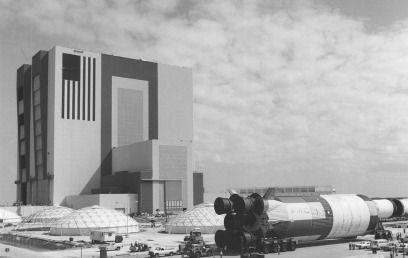A Saturn V’s Final Journey: From Mildew to Museum
A new book recounts (sort of) the difficult restoration of a deteriorating Saturn V

The Saturn V rocket was moved outside the Vehicle Assembly Building for the U.S. Bicentennial celebrations. Photo: NASA / Kennedy Space Center
When the Apollo program ended in 1972, one lonely Saturn V was left at NASA’s Kennedy Space Center in Florida. The never-was Apollo 18 rocket was dismantled into stages, then reassembled in front of the Vehicle Assembly Building in 1975 as part of the U.S. Bicentennial celebrations the following year. And there it continued to sit for two decades, rotting in the Florida humidity. In 1996, the Smithsonian teamed up with NASA to restore the Saturn V and give it a new home, protected from the elements, with a full educational experience for Kennedy Space Center visitors.
But this wasn’t as simple as it was with the newly built rocket in the 70s. “The Saturn rocket was pocked with gaping tears, rusted rivets, frayed wire, and fungi and other plant growths,” writes Andrew R. Thomas and Paul N. Thomarios in their new book, The Final Journey of the Saturn V. And Thomarios would know: he’s the president of The Apostolos Group, the team that was hired to do the rocket restoration.
Thomarios shares his firsthand knowledge of the grueling process to clean, repair, and move the five-stage vehicle into its new museum-quality building. It’s depressing to read the state the Saturn V had been left in for so long:
The rocket parts were covered with mildew, chewing gum, bird feces, and other items that defied description, but stuck to the rocket’s exterior. The gunk was so think that Nick Bolea, a long time Thomarios employee, decided to get on his employer’s good side by using a power-washer to write “Thomarios” in five-foot-high letters… stopped work one day because a mysterious purple runoff was oozing out of the rocket. A hazardous material team was summoned to investigate. After some analysis, the team discovered the material wasn’t dangerous after all, but was fruit juice from berries birds had stored in the rocket’s interior.
And that’s not including the difficulties in working with the rocket itself, even without the grimy handprint of Mother Nature: the asbestos in the heat panels, the detailed documentation required by the Smithsonian, the rigorous safety standards implemented by a post-Challenger NASA.
This largely untold story seems like a fascinating focus for a book. It’s too bad The Final Journey only really gets to it in the last chapter, and not in the kind of detail you’d expect for, you know, a book. The first hundred pages of the 120-page book are a brief summary of the space program, from President Kennedy’s 1961 moon speech through Apollo — presumably to explain to the reader why this massive restoration was embarked on, though it seems unnecessary for anyone who would pick up a book with “Saturn V” in the title. There are 24 pages of color photos, many provided by Thomarios and not seen elsewhere, from the restoration, which are worth seeing. A space program follower won’t get much more from it, unfortunately, but The Final Journey would be a nice read for the young burgeoning space fan.